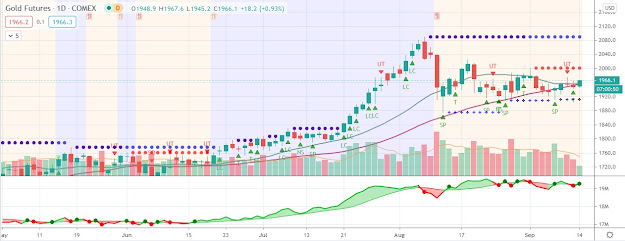Dramatic selling in gold as good news for the economy became bad news as the FOMC dashed hopes of more easing.
The gold price slid $22.46, or 1.4%, to $1,624.34 per ounce on Wednesday as yesterday’s sell-off in precious metals continued this morning. The price of gold declined amid strength in the U.S. dollar after the March ADP Employment Report came in at 209,000 – ahead of the 206,000 consensus estimate among economists.
Commenting on the yellow metal’s weakness, RBC Wealth Management’s George Gero wrote in a note to clients that “Dramatic selling in gold as good news for the economy became bad news (Tuesday) as the FOMC dashed hopes of more easing.” Analysts at UBS offered their own take on the gold sell-off, contending that “Gold really does need the physical market to step in right now…So far the response has been limited. The jewelers’ strike in India persists, overnight demand from that region was poor and the Chinese market is closed, but returning tomorrow.”
The gold price, along with most other U.S. dollar-denominated asset classes, initially suffered steep losses after the Fed minutes were published. However, the markets – albeit the price of gold less so than cyclically-sensitive commodities and stocks – pared their losses as the close of trading approached.
The modest rebound in the markets coincided with the release of a note by Jan Hatzius, Goldman Sachs’ chief U.S. economist. Hatzius, who recently predicted that the Ben Bernanke-led central bank will launch QE3 by June of this year, reiterated his monetary policy forecast in spite of Tuesday’s Fed minutes.
Commenting on the latest developments, Hatzius acknowledged that “Minutes from the March 13 FOMC meeting showed that the committee did not discuss monetary easing options in detail, in contrast to our expectations…March FOMC minutes make easing at April meeting unlikely without substantial deterioration in the outlook.”
However, the Goldman Sachs economist went on to say that “Officials’ views on the (economic) outlook were only a little more upbeat than previously.” In summary, Hatzius asserted that “an announcement of additional asset purchases remains our baseline, with June the most likely timing at this point.”
Commenting on the yellow metal’s weakness, RBC Wealth Management’s George Gero wrote in a note to clients that “Dramatic selling in gold as good news for the economy became bad news (Tuesday) as the FOMC dashed hopes of more easing.” Analysts at UBS offered their own take on the gold sell-off, contending that “Gold really does need the physical market to step in right now…So far the response has been limited. The jewelers’ strike in India persists, overnight demand from that region was poor and the Chinese market is closed, but returning tomorrow.”
The gold price, along with most other U.S. dollar-denominated asset classes, initially suffered steep losses after the Fed minutes were published. However, the markets – albeit the price of gold less so than cyclically-sensitive commodities and stocks – pared their losses as the close of trading approached.
The modest rebound in the markets coincided with the release of a note by Jan Hatzius, Goldman Sachs’ chief U.S. economist. Hatzius, who recently predicted that the Ben Bernanke-led central bank will launch QE3 by June of this year, reiterated his monetary policy forecast in spite of Tuesday’s Fed minutes.
Commenting on the latest developments, Hatzius acknowledged that “Minutes from the March 13 FOMC meeting showed that the committee did not discuss monetary easing options in detail, in contrast to our expectations…March FOMC minutes make easing at April meeting unlikely without substantial deterioration in the outlook.”
However, the Goldman Sachs economist went on to say that “Officials’ views on the (economic) outlook were only a little more upbeat than previously.” In summary, Hatzius asserted that “an announcement of additional asset purchases remains our baseline, with June the most likely timing at this point.”




Comments
Post a Comment